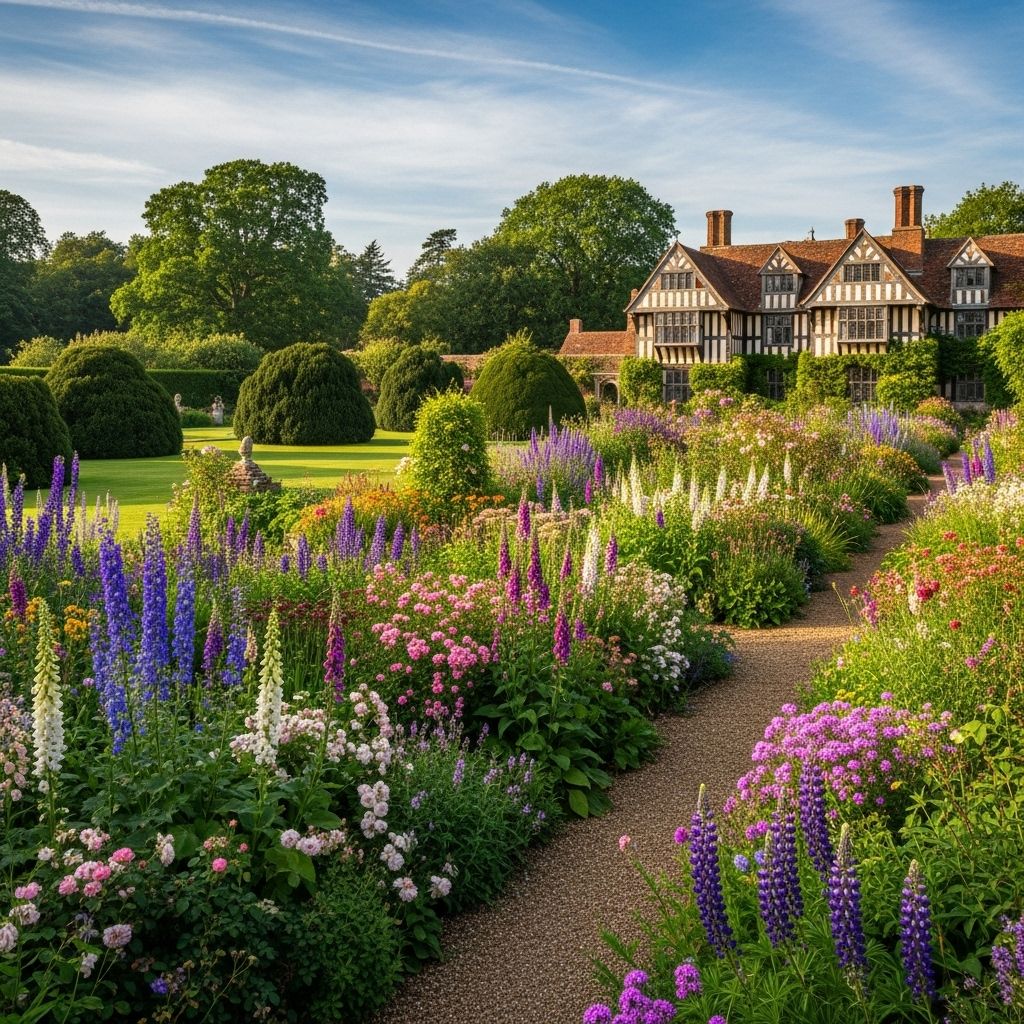Great Dixter Garden: Complete Guide To England’s Masterpiece
Explore the vibrant history, creative plantings, and enduring legacy of Great Dixter, England's unrivaled garden of ideas and inspiration.

Image: HearthJunction Design Team
Great Dixter: A Living Masterpiece of English Garden Design
Great Dixter stands as one of England’s most celebrated and talked-about gardens, revered worldwide for its creative tension between bold structure and exuberant planting. For decades, it has inspired not just gardeners but anyone who cherishes the vibrant interplay of tradition and innovation in design. At its core is a magnificent medieval manor, expanded and unified through the genius of architect Edwin Lutyens, and later transformed by the abundant imagination of Christopher Lloyd, one of Britain’s great horticultural minds.
What sets Great Dixter apart is its refusal to stand still. It is a living garden, constantly evolving, shaped by a restless intelligence and a passion for plantsmanship. Its perennial question—“Have you been to Great Dixter?”—remains as relevant now as it was in its heyday, challenging visitors to experience, question, and be inspired by a garden unlike any other.
The House: A Historic Foundation
Great Dixter is not just a garden—it is an architectural story spanning centuries. The heart of the estate is a captivating composite of English domestic architecture,
dating from the mid-15th century and lovingly expanded in the early 20th century.
- Original Manor House: Known as Dixter and dating back to the medieval era, its original timber-framed structure forms the core of today’s house.
- The Lloyd Acquisition: In 1909, businessman Nathaniel Lloyd, together with his wife Daisy, purchased Dixter and set about an ambitious project to restore and enlarge the home.
- Lutyens’ Vision: Renowned architect Sir Edwin Lutyens was commissioned between 1910 and 1912. He oversaw the restoration of the original hall, orchestrated the incorporation of a 16th-century Yeoman’s Hall transported from Benenden, Kent, and added new domestic wings.
Lutyens’ additions offered both bold contrast and utter harmony, creating what is now called Great Dixter—a romantic evocation of a medieval manor with all the comfort and artistry of the Arts and Crafts movement. - Architectural Legacy: Today, the house is Grade I listed for its architectural significance and remains a living symbol of English heritage and imagination.
Garden Design: Arts and Crafts Meets Wild Experimentation
While Lutyens’ hand is evident in the strong bones of the garden—the formal layouts, the topiary, the thoughtful spatial progression—the garden’s true character blossomed under the stewardship of Christopher Lloyd. Here, formality is both embraced and subverted: tightly clipped hedges and geometric lawns counterpoint explosions of color and texture that tumble exuberantly into view.
- Arts and Crafts Principles: The garden’s structure follows the Arts and Crafts tradition—outdoor rooms, intricate stonework, yew hedges, and timber gates echo the architectural language of the house.
- Inventive Planting: The real magic of Dixter lies in its audacious planting schemes—layered, experimental, unafraid of bold color clashes and unexpected combinations.
Plantings are always evolving, challenging visitors to reconsider the conventional rules of gardening. - Tradition Meets Innovation: The garden has always balanced formal structure with a wild, almost anarchic approach to planting, creating a dialogue between controlled design and natural abundance.
Core Elements of the Garden
- The Long Border: Perhaps the most famous element of Great Dixter, this exuberant border runs riot with perennials, annuals, and biennials, creating a constantly changing theatrical display from spring to autumn.
- Topiary Garden: Clipped yews and box form fantastical shapes—peacocks, pyramids, and sentinels—providing a strong visual scaffold for looser planting.
- Orchard & Wildflower Meadow: Expansive meadows and orchards, some centuries old, now form a vital part of the landscape. These are cut for hay in midsummer, then grazed, mimicking ancient practices and supporting local biodiversity.
- Exotic Exoticism: Great Dixter is known for daring combinations—tropical-style plantings, giant-leaved gunneras, and banana plants jostle alongside English cottage garden classics.
Christopher Lloyd: The Spirit Behind the Garden
Christopher Lloyd (1921–2006) was not only a gifted gardener but a writer, thinker, and fearless experimenter who made Great Dixter his lifelong laboratory. His bold rethinking of what an English garden could be changed the course of horticultural history, inspiring generations to break free from stale convention.
- Prolific Writing: Lloyd’s books and articles are celebrated for their wit, wisdom, and encouragement of creative risk-taking in the garden.
- Innovations: Lloyd was never afraid to dig up a rose garden to plant something more exciting or to mix tropical foliage with English perennials—a heresy at the time that is now widely admired.
- Mentorship: He fostered new generations of gardeners and plantspeople, making Great Dixter both a destination and a hub of horticultural exchange.
The Meadow: A Living Link to England’s Past
One of Dixter’s most awe-inspiring features is its ancient meadow, a rare survival of traditional English landscape management. For centuries, such meadows were cut for hay in midsummer and grazed by livestock in the autumn and winter.
- Biodiversity: The meadows support a dazzling variety of native wildflowers, insects, and birds.
- Ecological Inspiration: Thanks in large part to Great Dixter’s example, restoring meadows has surged in popularity among British gardeners, highlighting their crucial role in supporting wildlife and ecological health.
- Cultural Continuity: The meadow at Dixter is a living artifact, demonstrating the enduring value of traditional stewardship alongside innovative gardening.
Legacy and Continuing Inspiration
After Christopher Lloyd’s passing, the garden’s future was secured through the Great Dixter Charitable Trust. Today, Fergus Garrett, Lloyd’s chosen successor and longtime Head Gardener, leads a devoted team who continue to evolve the garden’s vision.
- Educational Mission: Great Dixter acts as a training ground for young gardeners, offering residencies, workshops, and international student exchanges.
- Dynamic Planting: Under Garrett’s leadership, the spirit of experimentation continues, with new plantings and design ideas debuting each season.
- Community & Outreach: The garden remains open to visitors, drawing gardeners and dreamers from around the globe.
It also hosts plant fairs, lectures, and courses that keep Dixter’s ethos of learning and sharing alive.
Historic Outbuildings and Landscape Features
Great Dixter’s appeal extends beyond its iconic house and main gardens. The estate is dotted with historic farm buildings, oast houses (used for drying hops), and barns that have been carefully preserved and now serve as vital parts of the garden’s operations.
- 18th-Century Oast Houses: A distinctive trio under a common roof, these are Grade II* listed and evoke the area’s agricultural past.
- 15th-Century Barn: Another Grade II* listed feature, it provides a dramatic backdrop and focal point for key garden vistas.
- Repurposed Sheds: Old farm buildings now house educational facilities, student accommodation, and support the garden’s work in ecological restoration.
Table: Key Features of Great Dixter
| Feature | Description | Heritage Status |
|---|---|---|
| Main House | Composite of 15th-century manor and 20th-century Arts & Crafts extensions | Grade I |
| Long Border | Famous mixed border, theatrical and ever-changing | Iconic Design |
| Wildflower Meadow | Ancient, species-rich meadow, cut for hay then grazed | Ecological Heritage |
| Oast Houses & Barn | 18th-century hop-drying houses and 15th-century barn | Grade II* |
| Topiary Garden | Yew and box shapes frame lush plantings | Signature Style |
Frequently Asked Questions (FAQs)
What makes Great Dixter unique among English gardens?
Great Dixter uniquely balances a strong, formal Arts and Crafts framework with exciting, informal, and often experimental plantings. Its commitment to constant evolution, combined with its historic house and meadow, make it a touchstone for gardeners worldwide.
Who was Christopher Lloyd and why is he important?
Christopher Lloyd (1921–2006) was a celebrated gardener, author, and plantsman who transformed Great Dixter into an icon of creative horticultural practice. His fearless experimentation and writing continue to inspire modern garden design.
Can I visit Great Dixter?
Yes. The garden, house, and estate buildings are open to the public at select times of the year. In addition to garden visits, Great Dixter offers workshops, lectures, and special events focused on gardening and plant conservation.
How does Great Dixter contribute to ecological gardening?
Great Dixter’s wildflower meadows, sustainable management practices, and ongoing restoration work serve as models for ecological gardening, helping to revive Britain’s vanishing biodiversity and traditional landscape features.
What is the role of the Great Dixter Charitable Trust?
The Trust was established to safeguard the house and garden after Christopher Lloyd’s death, ensuring that its educational mission and horticultural legacy continue for generations to come.
Conclusion: The Spirit of Innovation Lives On
Great Dixter stands as a symbol of what can be achieved when tradition is met with fearless innovation. Its layered history, architectural grandeur, and creative plantings offer endless inspiration—not only for gardeners but for anyone who treasures the dynamic interplay of past and present.
Above all, Great Dixter reminds us that the best gardens are never finished. They are works in progress—vibrant, challenging, and, in every season, gloriously alive.
References
- https://en.wikipedia.org/wiki/Great_Dixter
- https://www.gardendesign.com/english/great-dixter.html
- https://www.greatdixter.co.uk/about/history/christopher-lloyd/
- https://www.earlyoakreproductions.co.uk/news-blog/historic-britain/great-dixter-east-sussex-an-historic-house-of-three-parts.php
- https://thaddeussquire.substack.com/p/a-view-from-great-dixter
Read full bio of Srija Burman












